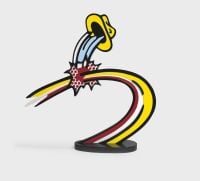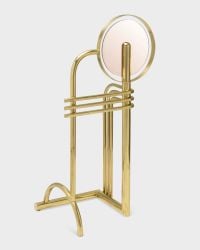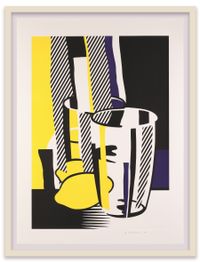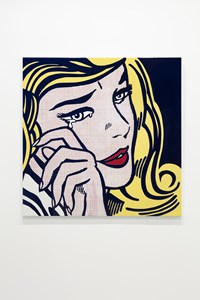Alongside artists such as Andy Warhol, Jasper Johns, and James Rosenquist, Roy Lichtenstein was a leading figure of the American Pop Art movement, amassing an important legacy through his painted parodies of comic strips and advertising techniques using the Ben-Day dot printing technique.
Read MoreComing from an upbringing in New York that was immersed in the arts, Roy Lichtenstein's earlier influences in the 1940s were artists like Rembrandt, Daumier, and Picasso, as well as Hoyt L. Sherman who taught Lichtenstein at Ohio State University and encouraged his critical perspective of accepted art canons.
Lichtenstein's fascination with vernacular commercial imagery developed throughout the 1940s and 50s. It was the outcome of experiments during his time teaching at Ohio State University and later the State University of New York at Oswego, and his academic hiatus in between spent working in various commercial and industrial professions in Cleveland. These ideas were fermented when teaching at Rutgers University's Douglass College in the late 1950s, where Lichtenstein's colleagues included Geoffrey Hendricks, Allan Kaprow, and George Segal.
The hallmarks of Roy Lichtenstein's Pop Art style emerged in the 1960s. Seminal large-scale works such as Drowning Girl (1963), and the iconic diptych Wham! (1963), borrowed and altered imagery found in romantic and action comic strips, advertisements, and chewing gum wrappers. Highlighting the lowly mass-produced origins of his subjects, Lichtenstein used homemade stencils and oil paint to recreate the Ben-Day dots used in commercial printing.
Roy Lichtenstein's art in the late 1960s continued to interrogate artistic processes, in particular landscape paintings and still lifes by artists like Cezanne, Mondrian, and Picasso, which he reimagined through his semi-abstract 'Brushstrokes' paintings (1965–1966).
This preceded Lichtenstein's experimentation with abstraction in the 1970s, characterised by simple lines and planes of colour. In the 1980s, he began parodying the gestural brushwork and abstract compositions of Abstract Expressionism with commercial techniques antithetical to that movement.
Alongside his paintings, Lichtenstein became heavily involved in printmaking and sculpture. His coloured bronze and steel sculptures are seemingly drawn on the three-dimensional space like his two-dimensional drawings and prints.
Lichtenstein was also a major contributor of public art. Throughout his career, he painted murals in North America, Europe, and the Middle East. He has also produced various forms of monumental sculpture since the late 1980s, which can be found in public spaces across the globe.
When Lichtenstein passed away in 1997, he left behind a legacy of light-hearted but intellectually rigorous works which, themselves, have ironically been appropriated and parodied for non-art purposes across the globe.
His works can be found in major institutions worldwide, including the Solomon R. Guggenheim Museum and Museum of Modern Art (MoMA) in New York, the Tate Modern in London, Centre Pompidou in Paris, Museum Ludwig in Cologne, National Gallery of Australia in Canberra, and Hara Museum of Contemporary Art in Tokyo.
The Loaded Brush, Galerie Thaddaeus Ropac, Salzburg, Austria (2019); Lichtenstein: A Retrospective, the Art Institute of Chicago, the National Gallery of Art, Washington DC, Tate Modern, London (2012–2013); Three Landscapes: A Film Installation by Roy Lichtenstein, Whitney Museum of American Art, New York (2012); Roy Lichtenstein: Sculpture, Gagosian, New York (2005); Roy Lichtenstein: All About Art, Louisiana Museum for Moderne Kunst, Humlebaek, Denmark (2003); Roy Lichtenstein: A Retrospective, Museum of Contemporary Art, Los Angeles (1994); Roy Lichtenstein 1970–1980, Fundación Juan March, Madrid (1983); Pop Art: Roy Lichtenstein, Neue Galerie der Stadt Aachen, Aachen, Germany (1975); Roy Lichtenstein, Leo Castelli Gallery, New York (1962).
Found, Made, Cast, Castelli Gallery, New York (2017); From Kandinsky to Pollock: the Art of the Guggenheim Collections, Palazzo Strozzi, Florence, Italy (2016); Les années Pop, 1956–1968, Centre Pompidou, Paris (2001); Drawing Now, MoMA, New York; Kunsthaus Zürich, Switzerland; Staatliche Kunsthalle Baden-Baden, Germany; Henie Onstad Kunstsenter, Høvikodden, Norway, Tel Aviv Museum, Israel (1976–1977); Art in the Mirror, MoMA, New York (1966); Six Painters and the Object, Solomon R. Guggenheim Museum, New York (1963); 66th Annual American Exhibition: Directions in Contemporary Painting and Sculpture, Art Institute of Chicago (1963); Drawings: Lee Bontecou, Jasper Johns, Roy Lichtenstein, Robert Rauschenberg, Jack Tworkov, Leo Castelli Gallery, New York (1962).
Michael Irwin | Ocula | 2020







